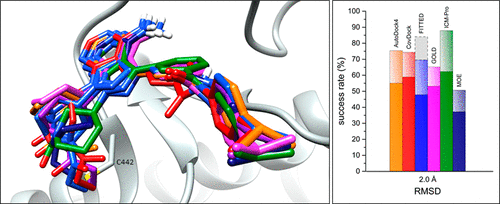当前位置:
X-MOL 学术
›
J. Chem. Inf. Model.
›
论文详情
Our official English website, www.x-mol.net, welcomes your
feedback! (Note: you will need to create a separate account there.)
Comparative Evaluation of Covalent Docking Tools
Journal of Chemical Information and Modeling ( IF 5.6 ) Pub Date : 2018-06-11 00:00:00 , DOI: 10.1021/acs.jcim.8b00228 Andrea Scarpino 1 , György G. Ferenczy 1 , György M. Keserű 1
Journal of Chemical Information and Modeling ( IF 5.6 ) Pub Date : 2018-06-11 00:00:00 , DOI: 10.1021/acs.jcim.8b00228 Andrea Scarpino 1 , György G. Ferenczy 1 , György M. Keserű 1
Affiliation

|
Increased interest in covalent drug discovery led to the development of computer programs predicting binding mode and affinity of covalent inhibitors. Here we compare the performance of six covalent docking tools, AutoDock4, CovDock, FITTED, GOLD, ICM-Pro, and MOE, for reproducing experimental binding modes in an unprecedently large and diverse set of covalent complexes. It was found that 40–60% of the top scoring ligand poses are within 2.0 Å RMSD from the experimental binding mode. This rate showed program dependent increase and achieved 50–90% when the best RMSD among the top ten scoring poses was considered. This performance is comparable to that of noncovalent docking tools and therefore suggests that anchoring the ligand does not necessarily improve the accuracy of the prediction. The effect of various ligand and protein features on the docking performance was investigated. At the level of warhead chemistry, higher success rate was found for Michael additions, nucleophilic additions and nucleophilic substitutions than for ring opening reactions and disulfide formation. Increasing ligand size and flexibility generally affects pose predictions unfavorably, although AutoDock4, FITTED, and ICM-Pro were found to be less sensitive up to 35 heavy atoms. Increasing the accessibility of the target cysteine tends to result in improved binding mode predictions. Docking programs show protein dependent performance suggesting a target-dependent choice of the optimal docking tool. It was found that noncovalent docking into Cys/Ala mutated proteins by ICM-Pro and Glide reproduced experimental binding modes with only slightly lower performance and at a significantly lower computational expense than covalent docking did. Overall, our results highlight the key factors influencing the docking performance of the investigated tools and they give guidelines for selecting the optimal combination of warheads, ligands, and tools for the system investigated. Results also identify the most important aspects to be considered for developing improved protocols for docking and virtual screening of covalent ligands.
中文翻译:

共价对接工具的比较评估
对共价药物发现的兴趣增加,导致计算机程序的发展预测了共价抑制剂的结合模式和亲和力。在这里,我们比较了六个共价对接工具AutoDock4,CovDock,FITTED,GOLD,ICM-Pro和MOE的性能,它们以前所未有的庞大和多样的共价复合体集重现实验性结合模式。研究发现,得分最高的配体姿态中有40–60%位于实验结合模式的2.0ÅRMSD之内。当考虑前十个得分姿势中最佳的RMSD时,该比率显示出程序依赖性增加,并达到50-90%。该性能可与非共价对接工具相媲美,因此表明锚定配体并不一定会提高预测的准确性。研究了各种配体和蛋白质特征对对接性能的影响。在弹头化学水平上,发现迈克尔加成,亲核加成和亲核取代的成功率高于开环反应和二硫化物形成的成功率。尽管发现AutoDock4,FITTED和ICM-Pro在多达35个重原子时不那么敏感,但是增加配体的大小和柔韧性通常会不利地影响姿势预测。靶标半胱氨酸的可及性的增加趋向于导致结合模式预测的改善。对接程序显示蛋白质依赖的性能,表明最佳对接工具的目标依赖选择。发现通过ICM-Pro和Glide非共价对接至Cys / Ala突变蛋白中的方法,与共价对接相比,其复制实验结合模式的性能仅稍低,且计算成本却低得多。总体而言,我们的研究结果突出显示了影响所研究工具对接性能的关键因素,并为选择适合于所研究系统的弹头,配体和工具的最佳组合提供了指导。结果还确定了开发对接和虚拟筛选共价配体的改进方案时应考虑的最重要方面。我们的研究结果突显了影响所研究工具对接性能的关键因素,并为选择适合于所研究系统的弹头,配体和工具的最佳组合提供了指导。结果还确定了开发对接和虚拟筛选共价配体的改进方案时应考虑的最重要方面。我们的研究结果突显了影响所研究工具对接性能的关键因素,并为选择适合于所研究系统的弹头,配体和工具的最佳组合提供了指导。结果还确定了开发对接和虚拟筛选共价配体的改进方案时应考虑的最重要方面。
更新日期:2018-06-11
中文翻译:

共价对接工具的比较评估
对共价药物发现的兴趣增加,导致计算机程序的发展预测了共价抑制剂的结合模式和亲和力。在这里,我们比较了六个共价对接工具AutoDock4,CovDock,FITTED,GOLD,ICM-Pro和MOE的性能,它们以前所未有的庞大和多样的共价复合体集重现实验性结合模式。研究发现,得分最高的配体姿态中有40–60%位于实验结合模式的2.0ÅRMSD之内。当考虑前十个得分姿势中最佳的RMSD时,该比率显示出程序依赖性增加,并达到50-90%。该性能可与非共价对接工具相媲美,因此表明锚定配体并不一定会提高预测的准确性。研究了各种配体和蛋白质特征对对接性能的影响。在弹头化学水平上,发现迈克尔加成,亲核加成和亲核取代的成功率高于开环反应和二硫化物形成的成功率。尽管发现AutoDock4,FITTED和ICM-Pro在多达35个重原子时不那么敏感,但是增加配体的大小和柔韧性通常会不利地影响姿势预测。靶标半胱氨酸的可及性的增加趋向于导致结合模式预测的改善。对接程序显示蛋白质依赖的性能,表明最佳对接工具的目标依赖选择。发现通过ICM-Pro和Glide非共价对接至Cys / Ala突变蛋白中的方法,与共价对接相比,其复制实验结合模式的性能仅稍低,且计算成本却低得多。总体而言,我们的研究结果突出显示了影响所研究工具对接性能的关键因素,并为选择适合于所研究系统的弹头,配体和工具的最佳组合提供了指导。结果还确定了开发对接和虚拟筛选共价配体的改进方案时应考虑的最重要方面。我们的研究结果突显了影响所研究工具对接性能的关键因素,并为选择适合于所研究系统的弹头,配体和工具的最佳组合提供了指导。结果还确定了开发对接和虚拟筛选共价配体的改进方案时应考虑的最重要方面。我们的研究结果突显了影响所研究工具对接性能的关键因素,并为选择适合于所研究系统的弹头,配体和工具的最佳组合提供了指导。结果还确定了开发对接和虚拟筛选共价配体的改进方案时应考虑的最重要方面。











































 京公网安备 11010802027423号
京公网安备 11010802027423号